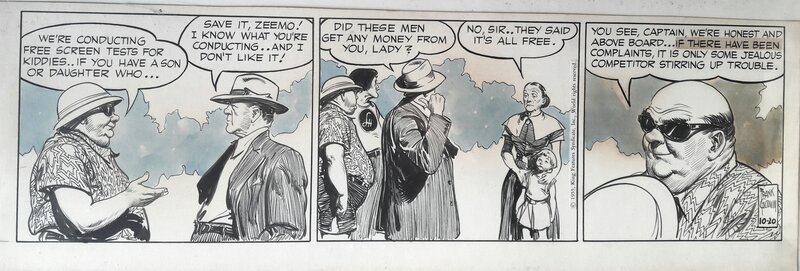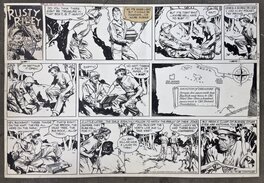In MATHO 's collection
Description
Strip de Rusty Riley par Frank Godwin, daté de 1955 pour la King Features Syndicate.
Inscriptions
Signée à l'origine
Comment
C'est d'abord ce ciel bleu qui attire l'oeil, sur les strips originaux de Rusty Riley. Puis on s'approche pour regarder en détail la façon dont Frank Godwin s'y prends pour dépeindre une scène. Enfin, on s'aperçoit que nous avons a faire à un génie du dessin qui, par la mise en mouvement de ses personnages, nous raconte une histoire à laquelle on s'attache.
Thematics
9 comments
To leave a comment on that piece, please log in
About Frank Godwin
Francis Godwin (October 20, 1889 – August 5, 1959), better known as Frank Godwin, was an American illustrator and comic strip artist, notable for his strip Connie and his book illustrations for Treasure Island, Kidnapped, Robinson Crusoe, Robin Hood and King Arthur. He also was a prolific editorial and advertising illustrator.
Born in Washington, D.C., Godwin was the son of the Washington Star's city editor, and in 1905, at age 16, he began as an apprentice on his father's paper. Studying in New York at the Art Students League, Godwin became friends with James Montgomery Flagg and two shared a studio together. Godwin was influenced by Flagg and Charles Dana Gibson, and reflections of both can be seen in Godwin's work.[1] Illustration historian and critic Jim Vadeboncoeur gave Godwin the highest ranking:
While obviously influenced by Flagg (and Charles Dana Gibson), Godwin managed to create a style that was recognizably his and that stood out from both his idols and the mass of clones that were cropping up everywhere. His ability to create tones, especially facial characteristics, with his pen and brush were equal to and in some ways better than Gibson and, I think, obviously superior to Flagg. His use of pen and brush in the same illustration demonstrated an understanding of the medium that set his work apart from his contemporaries.





